Pumping Station Desing - Second Edition by Robert L. Sanks, George Tchobahoglous, Garr M. Jones
Подождите немного. Документ загружается.

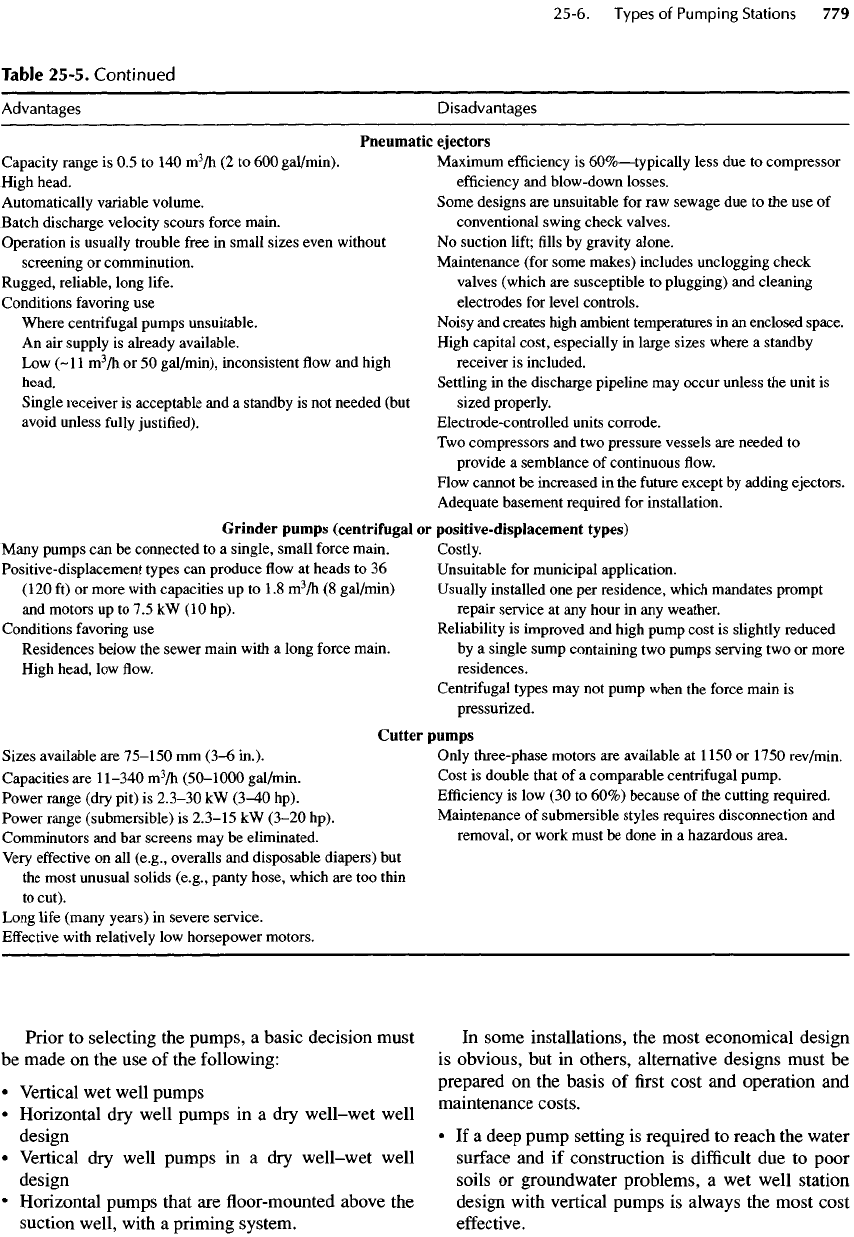
Table
25-5.
Continued
Advantages
Disadvantages
Pneumatic
ejectors
Capacity range
is 0.5 to 140
m
3
/h
(2 to 600
gal/min).
High
head.
Automatically
variable volume.
Batch
discharge velocity scours force main.
Operation
is
usually trouble
free
in
small sizes even without
screening
or
comminution.
Rugged,
reliable, long
life.
Conditions
favoring
use
Where centrifugal pumps unsuitable.
An
air
supply
is
already available.
Low
(~1
1
m
3
/h
or 50
gal/min), inconsistent
flow and
high
head.
Single receiver
is
acceptable
and a
standby
is not
needed (but
avoid
unless
fully
justified).
Maximum
efficiency
is
60%
—
typically
less
due to
compressor
efficiency
and
blow-down
losses.
Some designs
are
unsuitable
for raw
sewage
due to the use of
conventional swing check valves.
No
suction
lift;
fills by
gravity alone.
Maintenance (for some makes) includes unclogging check
valves
(which
are
susceptible
to
plugging)
and
cleaning
electrodes
for
level controls.
Noisy
and
creates high ambient temperatures
in an
enclosed space.
High capital cost, especially
in
large sizes where
a
standby
receiver
is
included.
Settling
in the
discharge pipeline
may
occur unless
the
unit
is
sized properly.
Electrode-controlled units
corrode.
Two
compressors
and two
pressure vessels
are
needed
to
provide
a
semblance
of
continuous
flow.
Flow cannot
be
increased
in the
future
except
by
adding ejectors.
Adequate basement required
for
installation.
Grinder
pumps (centrifugal
or
positive-displacement types)
Many
pumps
can be
connected
to a
single, small force main.
Positive-displacement types
can
produce
flow at
heads
to 36
(120
ft) or
more with capacities
up to 1.8
m
3
/h
(8
gal/min)
and
motors
up to 7.5 kW (10
hp).
Conditions
favoring
use
Residences below
the
sewer main with
a
long force main.
High
head,
low flow.
Costly.
Unsuitable
for
municipal application.
Usually
installed
one per
residence, which mandates prompt
repair service
at any
hour
in any
weather.
Reliability
is
improved
and
high pump cost
is
slightly reduced
by
a
single sump containing
two
pumps serving
two or
more
residences.
Centrifugal
types
may not
pump when
the
force main
is
pressurized.
Cutter
pumps
Sizes available
are
75-150
mm
(3-6
in.).
Capacities
are
11-340
m
3
/h
(50-1000
gal/min.
Power range (dry
pit)
is
2.3-30
kW
(3^0
hp).
Power range (submersible)
is
2.3-15
kW
(3-20 hp).
Comminutors
and bar
screens
may be
eliminated.
Very
effective
on all
(e.g., overalls
and
disposable diapers)
but
the
most unusual solids (e.g., panty hose, which
are too
thin
to
cut).
Long
life
(many years)
in
severe service.
Effective
with relatively
low
horsepower motors.
Prior
to
selecting
the
pumps,
a
basic
decision
must
be
made
on the use of the
following:
•
Vertical
wet
well pumps
•
Horizontal
dry
well pumps
in a dry
well-wet
well
design
•
Vertical
dry
well pumps
in a dry
well-wet
well
design
•
Horizontal pumps that
are floor-mounted
above
the
suction well, with
a
priming
system.
Only
three-phase motors
are
available
at
1
150
or
1750
rev/min.
Cost
is
double that
of a
comparable centrifugal pump.
Efficiency
is low (30 to
60%) because
of the
cutting required.
Maintenance
of
submersible styles requires disconnection
and
removal,
or
work
must
be
done
in a
hazardous area.
In
some installations,
the
most
economical
design
is
obvious,
but in
others,
alternative designs must
be
prepared
on the
basis
of first
cost
and
operation
and
maintenance
costs.
• If a
deep
pump setting
is
required
to
reach
the
water
surface
and if
construction
is
difficult
due to
poor
soils
or
ground water problems,
a wet
well station
design with vertical pumps
is
always
the
most cost
effective.
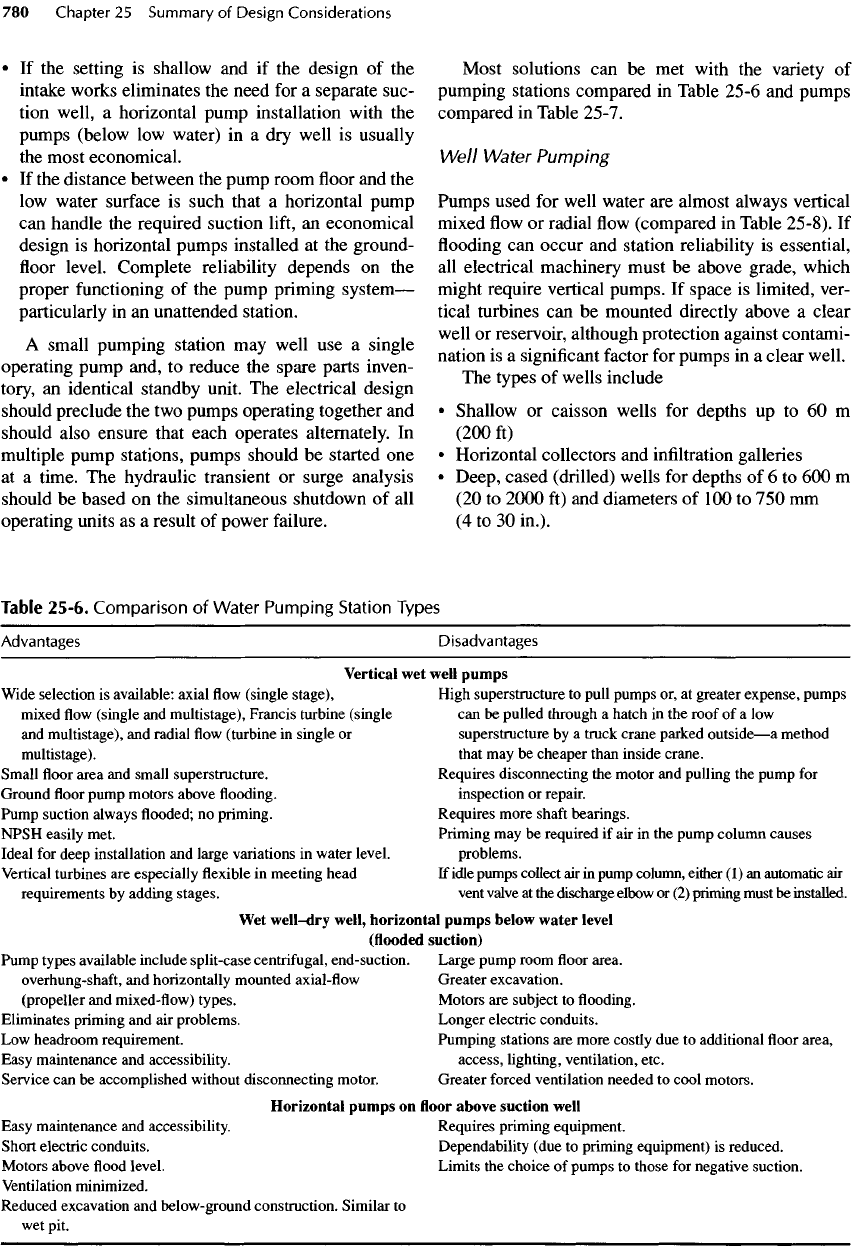
• If the
setting
is
shallow
and if the
design
of the
intake works eliminates
the
need
for a
separate suc-
tion
well,
a
horizontal pump installation
with
the
pumps
(below
low
water)
in a dry
well
is
usually
the
most economical.
• If the
distance between
the
pump room
floor and the
low
water
surface
is
such that
a
horizontal pump
can
handle
the
required suction
lift,
an
economical
design
is
horizontal pumps installed
at the
ground-
floor
level.
Complete reliability depends
on the
proper
functioning
of the
pump priming
system
—
particularly
in an
unattended station.
A
small pumping station
may
well
use a
single
operating pump and,
to
reduce
the
spare parts inven-
tory,
an
identical standby unit.
The
electrical
design
should
preclude
the two
pumps operating together
and
should
also ensure that each operates alternately.
In
multiple
pump stations, pumps should
be
started
one
at
a
time.
The
hydraulic transient
or
surge analysis
should
be
based
on the
simultaneous shutdown
of all
operating
units
as a
result
of
power
failure.
Most solutions
can be met
with
the
variety
of
pumping
stations compared
in
Table 25-6
and
pumps
compared
in
Table 25-7.
Well
Water
Pumping
Pumps used
for
well water
are
almost always vertical
mixed
flow or
radial
flow
(compared
in
Table 25-8).
If
flooding
can
occur
and
station reliability
is
essential,
all
electrical machinery must
be
above grade, which
might
require vertical pumps.
If
space
is
limited, ver-
tical
turbines
can be
mounted directly above
a
clear
well
or
reservoir, although protection against contami-
nation
is a
significant
factor
for
pumps
in a
clear well.
The
types
of
wells include
•
Shallow
or
caisson wells
for
depths
up to 60 m
(200
ft)
•
Horizontal collectors
and
infiltration
galleries
•
Deep, cased (drilled) wells
for
depths
of 6 to 600 m
(20 to
2000
ft) and
diameters
of 100 to 750 mm
(4
to 30
in.).
Table 25-6.
Comparison
of
Water
Pumping
Station
Types
Advantages
Disadvantages
Vertical
wet
well pumps
Wide selection
is
available: axial
flow
(single stage),
mixed
flow
(single
and
multistage), Francis turbine (single
and
multistage),
and
radial
flow
(turbine
in
single
or
multistage).
Small
floor
area
and
small superstructure.
Ground
floor
pump motors above
flooding.
Pump suction always
flooded; no
priming.
NPSH easily met.
Ideal
for
deep installation
and
large variations
in
water level.
Vertical
turbines
are
especially
flexible in
meeting head
requirements
by
adding
stages.
High superstructure
to
pull pumps
or, at
greater expense, pumps
can
be
pulled through
a
hatch
in the
roof
of a low
superstructure
by a
truck crane parked
outside
—
a
method
that
may be
cheaper than inside crane.
Requires disconnecting
the
motor
and
pulling
the
pump
for
inspection
or
repair.
Requires more
shaft
bearings.
Priming
may be
required
if air in the
pump column causes
problems.
If
idle pumps collect
air in
pump column, either
(1)
an
automatic
air
vent valve
at the
discharge elbow
or (2)
priming must
be
installed.
Wet
well-dry
well,
horizontal
pumps
below
water
level
(flooded suction)
Pump types available include split-case centrifugal,
end-suction,
overhung-shaft,
and
horizontally mounted axial-flow
(propeller
and
mixed-flow) types.
Eliminates priming
and air
problems.
Low
headroom requirement.
Easy maintenance
and
accessibility.
Service
can be
accomplished without disconnecting motor.
Large pump room
floor
area.
Greater excavation.
Motors
are
subject
to flooding.
Longer
electric
conduits.
Pumping stations
are
more costly
due to
additional
floor
area,
access,
lighting, ventilation, etc.
Greater forced ventilation needed
to
cool motors.
Horizontal
pumps
on floor
above
suction
well
Easy maintenance
and
accessibility.
Short electric conduits.
Motors above
flood
level.
Ventilation minimized.
Reduced excavation
and
below-ground construction. Similar
to
wet
pit.
Requires priming equipment.
Dependability (due
to
priming equipment)
is
reduced.
Limits
the
choice
of
pumps
to
those
for
negative suction.
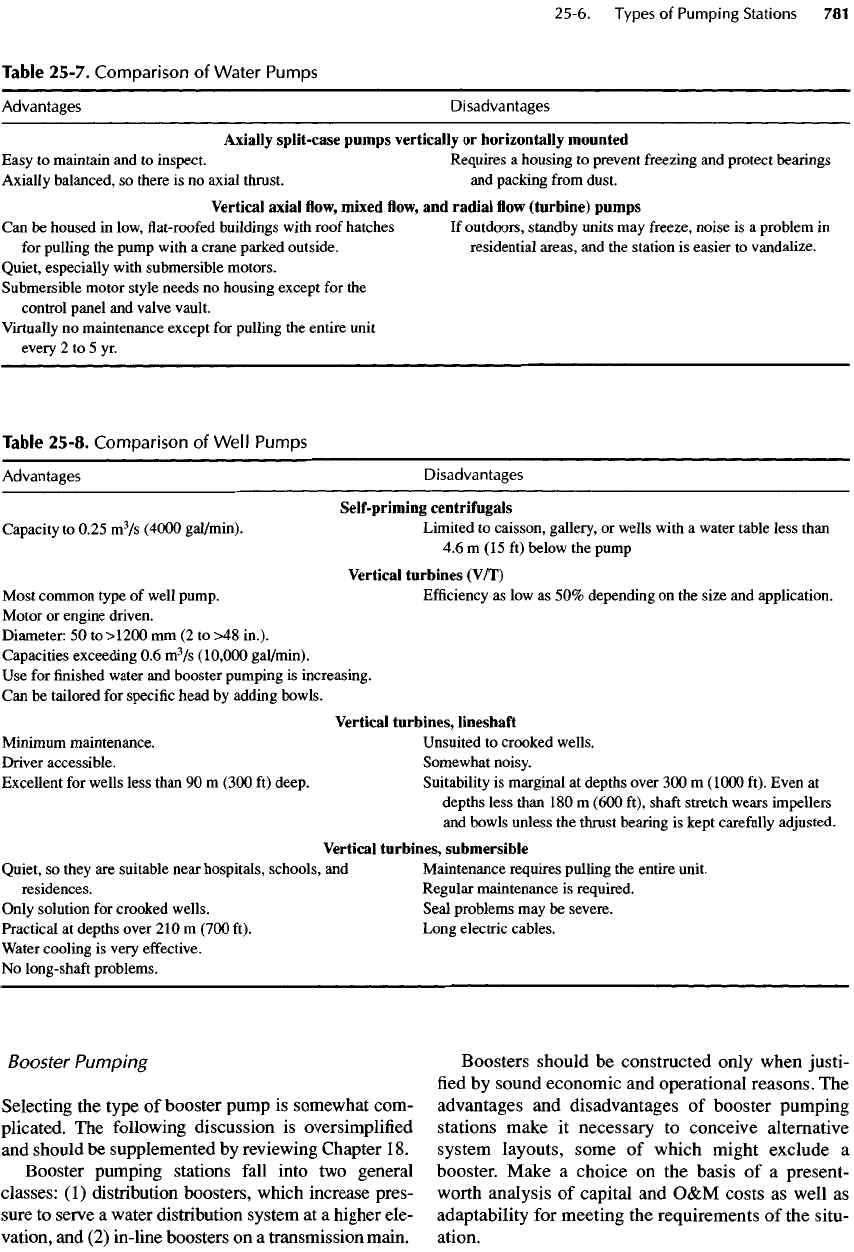
Booster Pumping
Selecting
the
type
of
booster pump
is
somewhat com-
plicated.
The
following
discussion
is
oversimplified
and
should
be
supplemented
by
reviewing Chapter
18.
Booster
pumping stations
fall
into
two
general
classes:
(1)
distribution boosters, which increase pres-
sure
to
serve
a
water distribution system
at a
higher ele-
vation,
and (2)
in-line boosters
on a
transmission main.
Boosters
should
be
constructed only when justi-
fied
by
sound economic
and
operational reasons.
The
advantages
and
disadvantages
of
booster pumping
stations
make
it
necessary
to
conceive alternative
system
layouts, some
of
which might exclude
a
booster. Make
a
choice
on the
basis
of a
present-
worth
analysis
of
capital
and O&M
costs
as
well
as
adaptability
for
meeting
the
requirements
of the
situ-
ation.
Table
25-7.
Comparison
of
Water
Pumps
Advantages
Disadvantages
Axially
split-case pumps vertically
or
horizontally mounted
Easy
to
maintain
and to
inspect.
Axially
balanced,
so
there
is no
axial thrust.
Requires
a
housing
to
prevent freezing
and
protect bearings
and
packing
from
dust.
Vertical
axial
flow,
mixed
flow, and
radial
flow
(turbine)
pumps
Can be
housed
in
low,
flat-roofed
buildings with roof hatches
for
pulling
the
pump with
a
crane parked outside.
Quiet, especially with submersible motors.
Submersible motor style needs
no
housing except
for the
control panel
and
valve vault.
Virtually
no
maintenance except
for
pulling
the
entire unit
every
2 to 5 yr.
If
outdoors, standby units
may
freeze, noise
is a
problem
in
residential areas,
and the
station
is
easier
to
vandalize.
Table
25-8. Comparison
of
Well Pumps
Advantages
Disadvantages
Self-priming centrifugals
Capacity
to
0.25
m
3
/s
(4000
gal/min).
Limited
to
caisson,
gallery,
or
wells with
a
water table less than
4.6 m (15 ft)
below
the
pump
Vertical
turbines
(V/T)
Most common type
of
well pump.
Efficiency
as low as 50%
depending
on the
size
and
application.
Motor
or
engine driven.
Diameter:
50 to
>1200
mm (2 to >48
in.).
Capacities exceeding
0.6
m
3
/s
(10,000
gal/min).
Use for
finished water
and
booster pumping
is
increasing.
Can be
tailored
for
specific head
by
adding bowls.
Vertical
turbines,
Hneshaft
Minimum
maintenance. Unsuited
to
crooked wells.
Driver accessible. Somewhat noisy.
Excellent
for
wells less than
90 m
(300
ft)
deep.
Suitability
is
marginal
at
depths over
300 m
(1000 ft). Even
at
depths less than
18Om
(600 ft),
shaft
stretch wears impellers
and
bowls unless
the
thrust bearing
is
kept carefully adjusted.
Vertical
turbines,
submersible
Quiet,
so
they
are
suitable near hospitals, schools,
and
residences.
Only
solution
for
crooked wells.
Practical
at
depths over
21Om
(700 ft).
Water cooling
is
very effective.
No
long-shaft problems.
Maintenance requires pulling
the
entire unit.
Regular maintenance
is
required.
Seal problems
may be
severe.
Long
electric
cables.
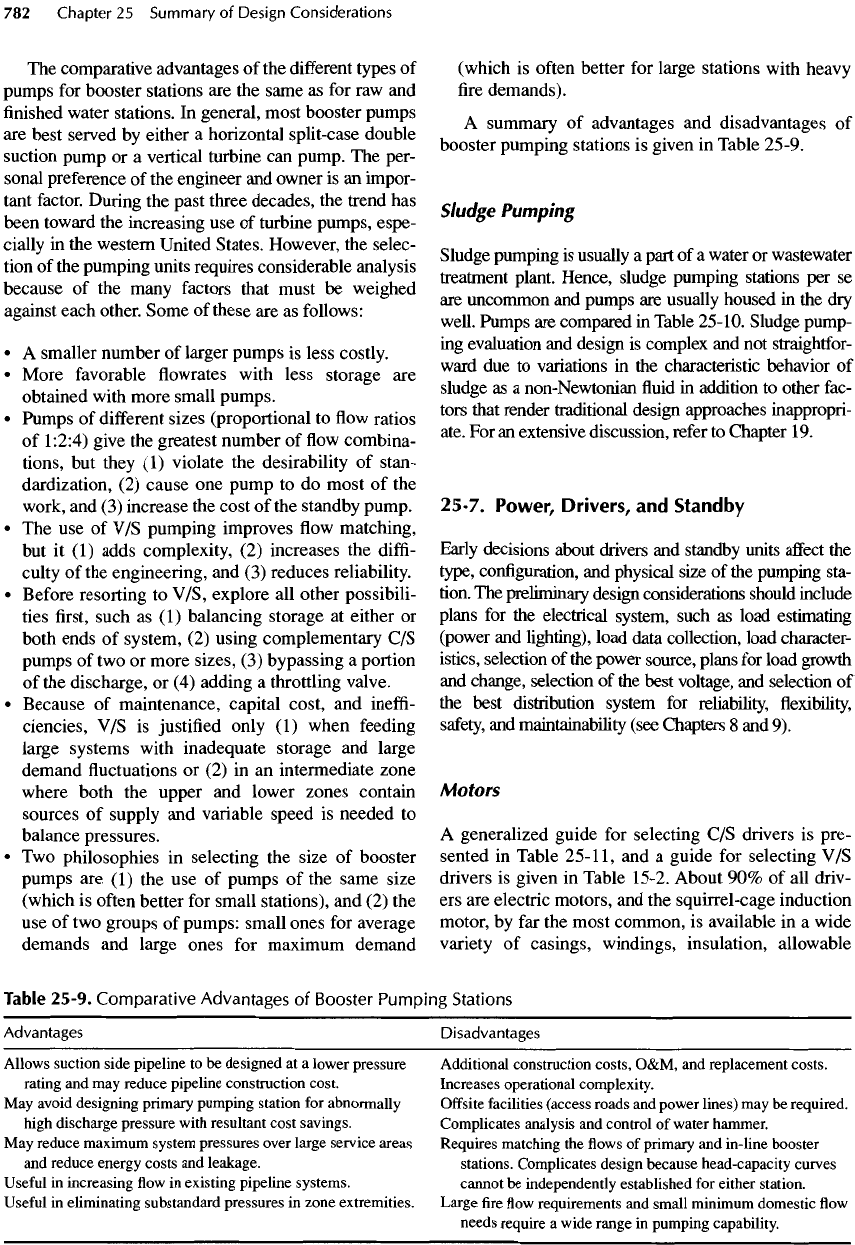
The
comparative advantages
of the
different
types
of
pumps
for
booster stations
are the
same
as for raw and
finished
water stations.
In
general, most booster pumps
are
best served
by
either
a
horizontal split-case double
suction
pump
or a
vertical turbine
can
pump.
The
per-
sonal preference
of the
engineer
and
owner
is an
impor-
tant
factor.
During
the
past three decades,
the
trend
has
been toward
the
increasing
use of
turbine pumps, espe-
cially
in the
western United States. However,
the
selec-
tion
of the
pumping units requires considerable analysis
because
of the
many factors that must
be
weighed
against each other. Some
of
these
are as
follows:
• A
smaller number
of
larger pumps
is
less
costly.
•
More favorable
flowrates
with less storage
are
obtained with more small pumps.
•
Pumps
of
different
sizes (proportional
to flow
ratios
of
1:2:4)
give
the
greatest number
of flow
combina-
tions,
but
they
(1)
violate
the
desirability
of
stan-
dardization,
(2)
cause
one
pump
to do
most
of the
work,
and (3)
increase
the
cost
of the
standby pump.
• The use of V/S
pumping improves
flow
matching,
but it (1)
adds complexity,
(2)
increases
the
diffi-
culty
of the
engineering,
and (3)
reduces reliability.
•
Before resorting
to
V/S, explore
all
other possibili-
ties
first,
such
as (1)
balancing storage
at
either
or
both ends
of
system,
(2)
using complementary
C/S
pumps
of two or
more sizes,
(3)
bypassing
a
portion
of
the
discharge,
or (4)
adding
a
throttling valve.
•
Because
of
maintenance, capital cost,
and
ineffi-
ciencies,
V/S is
justified
only
(1)
when feeding
large systems with inadequate storage
and
large
demand
fluctuations or (2) in an
intermediate zone
where both
the
upper
and
lower zones contain
sources
of
supply
and
variable speed
is
needed
to
balance pressures.
• Two
philosophies
in
selecting
the
size
of
booster
pumps
are (1) the use of
pumps
of the
same size
(which
is
often
better
for
small stations),
and (2) the
use of two
groups
of
pumps: small ones
for
average
demands
and
large ones
for
maximum demand
(which
is
often
better
for
large stations with heavy
fire
demands).
A
summary
of
advantages
and
disadvantages
of
booster pumping stations
is
given
in
Table 25-9.
Sludge
Pumping
Sludge pumping
is
usually
a
part
of a
water
or
wastewater
treatment plant. Hence, sludge pumping stations
per se
are
uncommon
and
pumps
are
usually housed
in the dry
well. Pumps
are
compared
in
Table
25-10.
Sludge pump-
ing
evaluation
and
design
is
complex
and not
straightfor-
ward
due to
variations
in the
characteristic behavior
of
sludge
as a
non-Newtonian
fluid in
addition
to
other fac-
tors
that
render traditional design approaches inappropri-
ate.
For an
extensive discussion,
refer
to
Chapter
19.
25-7. Power,
Drivers,
and
Standby
Early
decisions about drivers
and
standby units
affect
the
type,
configuration,
and
physical size
of the
pumping sta-
tion.
The
preliminary design considerations should include
plans
for the
electrical system, such
as
load estimating
(power
and
lighting), load data collection, load character-
istics, selection
of the
power source, plans
for
load growth
and
change,
selection
of the
best voltage,
and
selection
of
the
best distribution system
for
reliability,
flexibility,
safety,
and
maintainability (see Chapters
8 and 9).
Motors
A
generalized guide
for
selecting
C/S
drivers
is
pre-
sented
in
Table
25-11,
and a
guide
for
selecting
V/S
drivers
is
given
in
Table 15-2. About
90% of all
driv-
ers are
electric
motors,
and the
squirrel-cage induction
motor,
by far the
most common,
is
available
in a
wide
variety
of
casings,
windings, insulation, allowable
Table 25-9.
Comparative
Advantages
of
Booster
Pumping
Stations
Advantages
Disadvantages
Allows suction side
pipeline
to be
designed
at a
lower pressure Additional construction costs, O&M,
and
replacement
costs.
rating
and may
reduce pipeline construction cost. Increases operational complexity.
May
avoid designing primary pumping station
for
abnormally
Offsite
facilities (access roads
and
power lines)
may be
required.
high
discharge pressure
with
resultant cost savings. Complicates analysis
and
control
of
water hammer.
May
reduce
maximum
system pressures over large service areas Requires matching
the flows of
primary
and
in-line booster
and
reduce energy costs
and
leakage. stations. Complicates design because head-capacity curves
Useful
in
increasing
flow in
existing pipeline systems. cannot
be
independently established
for
either station.
Useful
in
eliminating substandard pressures
in
zone extremities. Large
fire flow
requirements
and
small minimum domestic
flow
needs require
a
wide range
in
pumping capability.
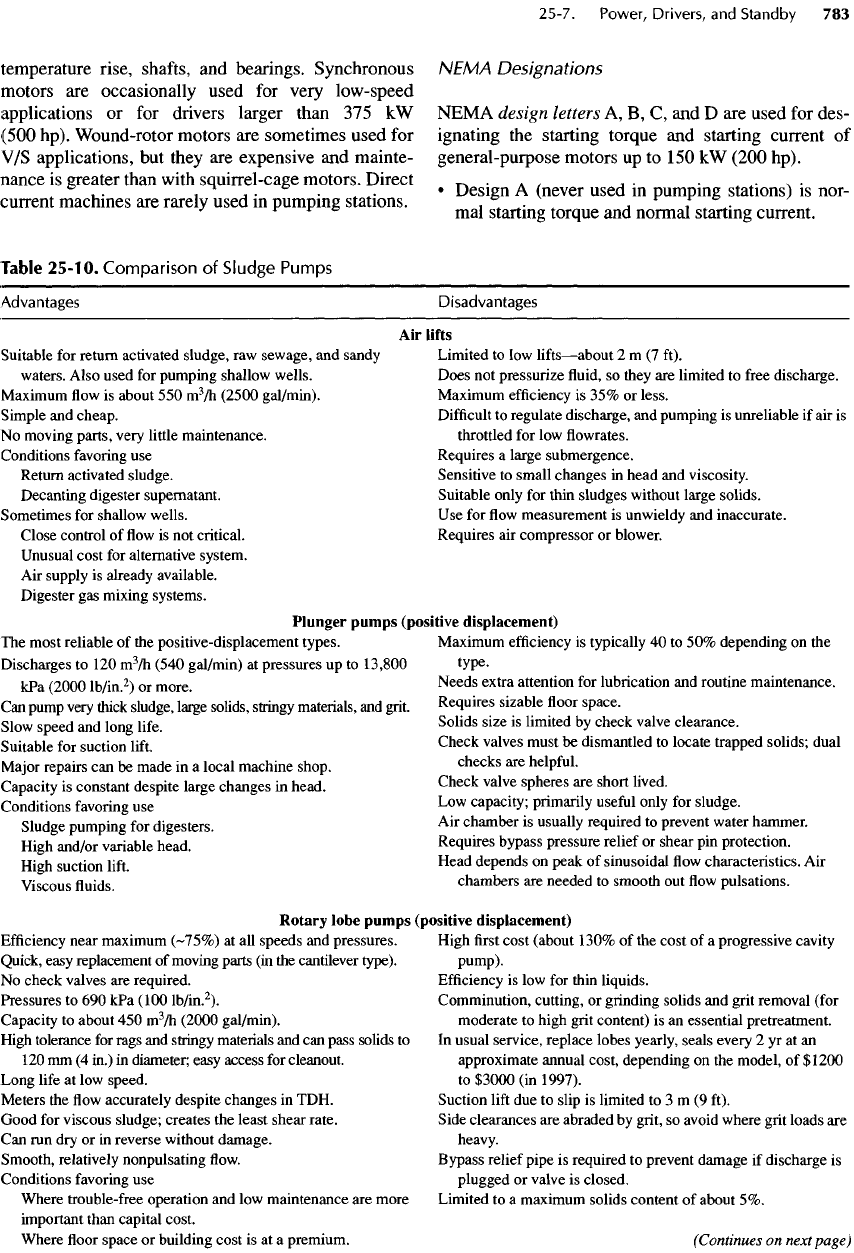
temperature
rise,
shafts,
and
bearings.
Synchronous
motors
are
occasionally
used
for
very
low-speed
applications
or for
drivers larger than
375 kW
(500
hp).
Wound-rotor
motors
are
sometimes
used
for
V/S
applications,
but
they
are
expensive
and
mainte-
nance
is
greater
than
with
squirrel-cage motors. Direct
current
machines
are
rarely
used
in
pumping
stations.
NEMA
Designations
NEMA
design
letters
A, B, C, and D are
used
for
des-
ignating
the
starting
torque
and
starting
current
of
general-purpose
motors
up to 150 kW
(200 hp).
•
Design
A
(never
used
in
pumping
stations)
is
nor-
mal
starting
torque
and
normal
starting current.
Table
25-10.
Comparison
of
Sludge
Pumps
Advantages
Disadvantages
Air
lifts
Suitable
for
return activated sludge,
raw
sewage,
and
sandy
waters.
Also used
for
pumping shallow wells.
Maximum
flow is
about
550
m
3
/h
(2500
gal/min).
Simple
and
cheap.
No
moving parts, very little maintenance.
Conditions
favoring
use
Return
activated sludge.
Decanting digester supernatant.
Sometimes
for
shallow wells.
Close control
of flow is not
critical.
Unusual
cost
for
alternative system.
Air
supply
is
already available.
Digester
gas
mixing systems.
Limited
to low
lifts
—
about
2 m (7
ft).
Does
not
pressurize
fluid, so
they
are
limited
to
free
discharge.
Maximum
efficiency
is 35% or
less.
Difficult
to
regulate discharge,
and
pumping
is
unreliable
if air is
throttled
for low flowrates.
Requires
a
large submergence.
Sensitive
to
small changes
in
head
and
viscosity.
Suitable only
for
thin sludges without large
solids.
Use for flow
measurement
is
unwieldy
and
inaccurate.
Requires
air
compressor
or
blower.
Plunger
pumps
(positive
displacement)
The
most reliable
of the
positive-displacement types.
Discharges
to 120
m
3
/h
(540 gal/min)
at
pressures
up to
13,800
kPa
(2000
lb/in.
2
)
or
more.
Can
pump very thick sludge, large solids, stringy materials,
and
grit.
Slow
speed
and
long
life.
Suitable
for
suction
lift.
Major
repairs
can be
made
in a
local machine shop.
Capacity
is
constant despite large changes
in
head.
Conditions favoring
use
Sludge
pumping
for
digesters.
High
and/or variable head.
High
suction
lift.
Viscous fluids.
Maximum
efficiency
is
typically
40 to 50%
depending
on the
type.
Needs extra attention
for
lubrication
and
routine maintenance.
Requires sizable
floor
space.
Solids size
is
limited
by
check valve clearance.
Check valves must
be
dismantled
to
locate trapped solids; dual
checks
are
helpful.
Check valve spheres
are
short lived.
Low
capacity; primarily
useful
only
for
sludge.
Air
chamber
is
usually required
to
prevent water hammer.
Requires bypass pressure relief
or
shear
pin
protection.
Head depends
on
peak
of
sinusoidal
flow
characteristics.
Air
chambers
are
needed
to
smooth
out flow
pulsations.
Rotary
lobe pumps (positive
displacement)
Efficiency
near maximum
(-75%)
at all
speeds
and
pressures.
Quick,
easy replacement
of
moving parts
(in the
cantilever type).
No
check valves
are
required.
Pressures
to 690 kPa
(100
lb/in.
2
).
Capacity
to
about
450
m
3
/h
(2000
gal/min).
High
tolerance
for
rags
and
stringy materials
and can
pass solids
to
120 mm (4
in.)
in
diameter; easy access
for
cleanout.
Long
life
at low
speed.
Meters
the flow
accurately despite changes
in
TDH.
Good
for
viscous sludge; creates
the
least shear rate.
Can run dry or in
reverse without damage.
Smooth, relatively nonpulsating
flow.
Conditions favoring
use
Where trouble-free operation
and low
maintenance
are
more
important than capital cost.
Where
floor
space
or
building cost
is at a
premium.
High
first
cost (about
130%
of the
cost
of a
progressive cavity
pump).
Efficiency
is low for
thin liquids.
Comminution, cutting,
or
grinding solids
and
grit removal (for
moderate
to
high grit content)
is an
essential pretreatment.
In
usual service, replace lobes yearly, seals every
2 yr at an
approximate
annual cost, depending
on the
model,
of
$1200
to
$3000
(in
1997).
Suction
lift
due to
slip
is
limited
to 3 m (9
ft).
Side clearances
are
abraded
by
grit,
so
avoid where grit loads
are
heavy.
Bypass
relief pipe
is
required
to
prevent damage
if
discharge
is
plugged
or
valve
is
closed.
Limited
to a
maximum solids content
of
about
5%.
(Continues
on
next
page)
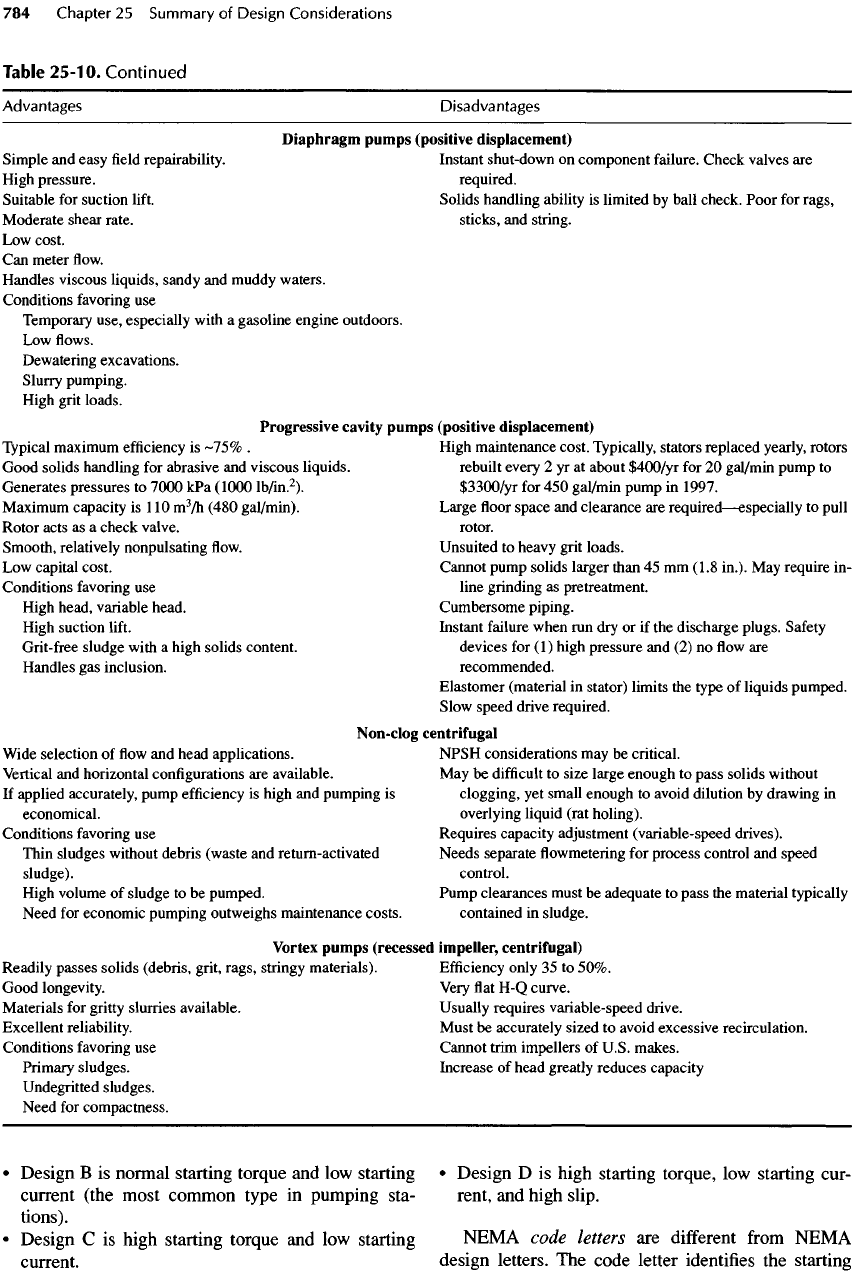
Table
25-10.
Continued
Advantages
Disadvantages
Diaphragm
pumps
(positive
displacement)
Simple
and
easy
field
repairability.
High pressure.
Suitable
for
suction
lift.
Moderate shear rate.
Low
cost.
Can
meter
flow.
Handles viscous liquids, sandy
and
muddy waters.
Conditions favoring
use
Temporary use, especially with
a
gasoline engine outdoors.
Low flows.
Dewatering
excavations.
Slurry
pumping.
High
grit loads.
Instant shut-down
on
component failure. Check valves
are
required.
Solids handling ability
is
limited
by
ball check. Poor
for
rags,
sticks,
and
string.
Progressive
cavity pumps (positive
displacement)
Typical
maximum
efficiency
is
~75%
.
Good solids handling
for
abrasive
and
viscous liquids.
Generates pressures
to
7000
kPa
(1000
lb/in.
2
).
Maximum
capacity
is
1
10
m
3
/h
(480
gal/min).
Rotor acts
as a
check valve.
Smooth, relatively nonpulsating
flow.
Low
capital cost.
Conditions favoring
use
High
head, variable head.
High suction
lift.
Grit-free
sludge with
a
high solids content.
Handles
gas
inclusion.
High
maintenance cost. Typically, stators replaced yearly, rotors
rebuilt every
2 yr at
about
$400/yr
for 20
gal/min pump
to
$3300/yr
for 450
gal/min pump
in
1997.
Large
floor
space
and
clearance
are
required
—
especially
to
pull
rotor.
Unsuited
to
heavy grit loads.
Cannot pump solids larger than
45 mm
(1.8
in.).
May
require
in-
line grinding
as
pretreatment.
Cumbersome piping.
Instant failure when
run dry or if the
discharge plugs. Safety
devices
for (1)
high pressure
and (2) no flow are
recommended.
Elastomer (material
in
stator) limits
the
type
of
liquids pumped.
Slow speed drive required.
Non-clog centrifugal
Wide selection
of flow and
head applications.
Vertical
and
horizontal configurations
are
available.
If
applied accurately, pump
efficiency
is
high
and
pumping
is
economical.
Conditions favoring
use
Thin sludges without debris (waste
and
return-activated
sludge).
High
volume
of
sludge
to be
pumped.
Need
for
economic pumping outweighs maintenance costs.
NPSH considerations
may be
critical.
May
be
difficult
to
size large enough
to
pass
solids
without
clogging,
yet
small enough
to
avoid dilution
by
drawing
in
overlying
liquid (rat holing).
Requires capacity adjustment
(variable-speed
drives).
Needs separate
flowmetering for
process control
and
speed
control.
Pump clearances must
be
adequate
to
pass
the
material typically
contained
in
sludge.
Vortex
pumps
(recessed
impeller,
centrifugal)
Readily passes solids (debris, grit, rags, stringy materials).
Efficiency
only
35 to
50%.
Good longevity. Very
flat H-Q
curve.
Materials
for
gritty slurries available. Usually requires variable-speed drive.
Excellent reliability. Must
be
accurately sized
to
avoid excessive recirculation.
Conditions favoring
use
Cannot trim impellers
of
U.S. makes.
Primary sludges.
Increase
of
head greatly reduces capacity
Undegritted
sludges.
Need
for
compactness.
•
Design
B is
normal
starting
torque
and low
starting
current
(the
most
common
type
in
pumping
sta-
tions).
•
Design
C is
high
starting
torque
and low
starting
current.
•
Design
D is
high
starting
torque,
low
starting
cur-
rent,
and
high
slip.
NEMA
code
letters
are
different
from
NEMA
design
letters.
The
code letter
identifies
the
starting

conditions
in
"kilovolt-amperes
per
horsepower"
when
the
motor
is
started
on
full
voltage.
These
data
are
primarily used
to
determine
if the
capability
of the
electric supply
or
on-site generator
is
sufficient
for
starting
and
picking
up the
load.
Starting
in-rush
current requirements
are
needed
for
sizing
the
emergency generators, conductors,
and
controllers
and are of
interest
to the
power company.
The
motor controls should permit starting only
one
unit
at a
time,
and if
drivers
of
different
sizes
are
used,
the
emergency generator size
can be
minimized
by
starting
the
largest motor
first.
Hazardous Locations
A
Class
1,
Division
1
wastewater
wet
well requires
full
containment
of
electrical conductors
and
equip-
ment.
A
non-explosionproof
submersible motor
can
be
made compliant
by
using
a
redundant low-level
float
switch
to
disconnect
the
motor
and
sound
an
alarm
when
the
liquid level
falls
to the top of the
motor.
Class
I,
Division
2
allows
the use of
non-explo-
sionproof wiring
and
equipment provided
it
does
not
produce arcs (see
NEC
501-3).
Close-Coupled Motors
Close-coupled motors have
a
long
shaft
that carries
the
pump impeller. Radial loads
for
multivaned impel-
lers pumping clear water
are
relatively small,
but
radial loads
for
impellers pumping
raw
sewage
are
large,
they
fluctuate
(twice
per
revolution
for a
two-
vane
impeller),
and
with large solids present,
the fluc-
tuations
are
irregular.
Shafts
or
bearings
and
seals
in a
close-coupled unit pumping sewage
may be
short
lived, particularly
at
high discharge heads, unless
the
unit
is
specially designed
for
severe service.
Motor Specifications
Motors located indoors
and
above grade
can
have
open dripproof enclosures. These
are the
least expen-
sive,
and
they allow motors
to run
cooler
than other
enclosures. Some designers suggest splashproof
enclosures
for
some environments
so
that
the
entire
area
can be
washed
with
a
hose.
To
provide protection
from
flooding,
specify
installations below grade
to be
either
(1)
open, dripproof enclosures with encapsu-
lated motor windings
or (2)
totally enclosed, fan-
cooled motors. Outdoor installations should
be
speci-
fied
as
Weather-Protected
II
enclosures.
For
Class
1,
Division
1
hazardous
locations,
specify that
"motors
shall
be
rated Class
1,
Division
1,"
which
is a
totally
enclosed, explosionproof motor.
For
Class
1,
Division
2
locations,
the
open, dripproof
enclosure
is
accept-
able
for
squirrel-cage motors
if
there
are no
switches
or
other arc-producing components
in the
motor.
Other specifications
for
motors should include:
•
Class
B
temperature
rise
•
Class
F
insulation
•
480-
V,
three-phase power
for
motors
from
2 to
about
60 kW (2 to
about
75 hp)
•
2300-V three-phase power
for
motors
of 75 kW
(lOOhp)
or
more
• A
service
factor
of
1
.
1
5
•
High energy
efficiency
and a
high power
factor
(because these terms have
no
accurate
definitions,
state
the
actual values
in the
specifications)
•
Blower, fan,
and
centrifugal pump motor torque
characteristics that
fit
NEMA Standards Design
B
•
Antifriction ball bearings with
a
life
of
100,000
for
motors
up to 300 kW
(400 hp); ball
or
roller bear-
ings
can be
used
•
NEMA code letters
F or G for
motors
of 150 kW
(200
hp) or
less
(see Chapter 13).
Variable
Speeds
Use V/S
drives only
if
necessary
and do not use
com-
plex control systems (such
as
AFD)
for
remotely located
pumping
stations except with
the
client's
full
under-
standing
of the
problems stated
in the
subsection enti-
tled "Adjustable-Frequency Drives"
in
Section
15-11.
Specify
unit responsibility (see Chapter
16)
for the
drive
and
pump, but,
if AFD is to be
used, either
(1)
specify
also
that guaranteed service
and
critical parts will
be
available within
a
reasonable
distance (say,
160 km or
100
mi) or (2)
make sure that
the
client will have trained
electronic technicians
on the
staff
or
that there
is a
reli-
able,
qualified
service organization nearby.
If V/S is
nec-
essary
and AFD
cannot
be
justified
and if
slightly higher
power losses
can be
tolerated, consider
the
simpler slip
drives such
as the
eddy-current coupling (see Sections
15-1
and
15-11).
One way to
"improve"
the
efficiency
of
slip
drives
is to
design
so
that
a
pump rarely operates
at
less than about
85% of
full
speed. Also consider
the
almost
100%-reliable
combined squirrel-cage motor/
diesel
engine drive where
the
engine with
a
larger rating
is
used both
for
peak
flow and for
standby power.
If V/S
is
used
for one
pump, there must
be a V/S
standby.
A
combination
of a V/S
pump
and a C/S
pump
is
satisfac-
tory
only
if the
discharge
capacity
of the V/S
pump
exceeds
the
capacity
of
the
CIS
pump
by at
least
50%.
If
the two
pumps have equal capacities,
the V/S
pump will
"starve"
on too
little
flow and
wear
out
quickly,
for the
reasons given
in
Sections 10-6
and
15-5.
Flat
H-Q
curves
for
both
the
pump
and the
system
must
be
avoided because, with
an
acute angle
of
inter-
section,
small changes
in
head (due
to air in the
force
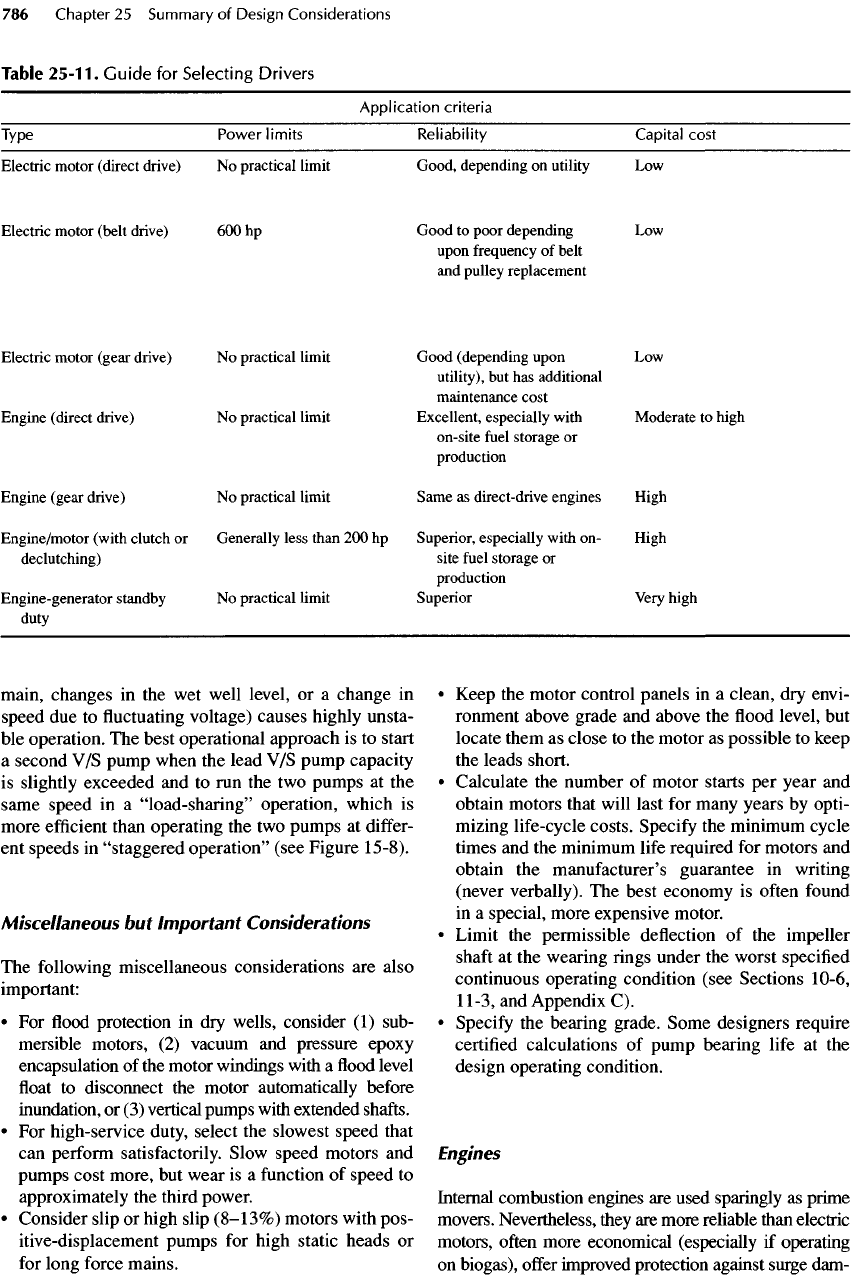
main,
changes
in the wet
well level,
or a
change
in
speed
due to fluctuating
voltage) causes highly unsta-
ble
operation.
The
best operational approach
is to
start
a
second
V/S
pump when
the
lead
V/S
pump capacity
is
slightly exceeded
and to run the two
pumps
at the
same speed
in a
"load-
sharing"
operation, which
is
more
efficient
than operating
the two
pumps
at
differ-
ent
speeds
in
"staggered
operation"
(see Figure 15-8).
Miscellaneous
but
Important
Considerations
The
following miscellaneous considerations
are
also
important:
• For flood
protection
in dry
wells, consider
(1)
sub-
mersible motors,
(2)
vacuum
and
pressure epoxy
encapsulation
of the
motor windings with
a flood
level
float to
disconnect
the
motor automatically before
inundation,
or (3)
vertical pumps with extended
shafts.
• For
high-service duty, select
the
slowest speed that
can
perform satisfactorily. Slow speed motors
and
pumps
cost more,
but
wear
is a
function
of
speed
to
approximately
the
third power.
•
Consider slip
or
high slip
(8-13%)
motors with pos-
itive-displacement pumps
for
high static heads
or
for
long force mains.
•
Keep
the
motor control panels
in a
clean,
dry
envi-
ronment
above grade
and
above
the flood
level,
but
locate them
as
close
to the
motor
as
possible
to
keep
the
leads short.
•
Calculate
the
number
of
motor starts
per
year
and
obtain motors that will last
for
many years
by
opti-
mizing
life-cycle costs. Specify
the
minimum cycle
times
and the
minimum
life
required
for
motors
and
obtain
the
manufacturer's guarantee
in
writing
(never verbally).
The
best economy
is
often
found
in
a
special, more expensive motor.
•
Limit
the
permissible deflection
of the
impeller
shaft
at the
wearing rings under
the
worst specified
continuous operating condition (see Sections 10-6,
11-3,
and
Appendix
C).
•
Specify
the
bearing grade. Some designers require
certified
calculations
of
pump bearing
life
at the
design operating condition.
Engines
Internal combustion engines
are
used sparingly
as
prime
movers. Nevertheless, they
are
more reliable than electric
motors,
often
more economical (especially
if
operating
on
biogas),
offer
improved protection against surge dam-
Type
Electric motor (direct drive)
Electric motor (belt drive)
Electric motor (gear drive)
Engine
(direct drive)
Engine
(gear drive)
Engine/motor
(with
clutch
or
declutching)
Engine-generator
standby
duty
Power
limits
No
practical limit
600 hp
No
practical limit
No
practical limit
No
practical limit
Generally
less than
200 hp
No
practical limit
Reliability
Good,
depending
on
utility
Good
to
poor
depending
upon
frequency
of
belt
and
pulley replacement
Good (depending upon
utility),
but has
additional
maintenance
cost
Excellent, especially with
on-site
fuel
storage
or
production
Same
as
direct-drive engines
Superior,
especially with
on-
site
fuel
storage
or
production
Superior
Capital
cost
Low
Low
Low
Moderate
to
high
High
High
Very
high
Table
25-11.
Guide
for
Selecting
Drivers
Application
criteria
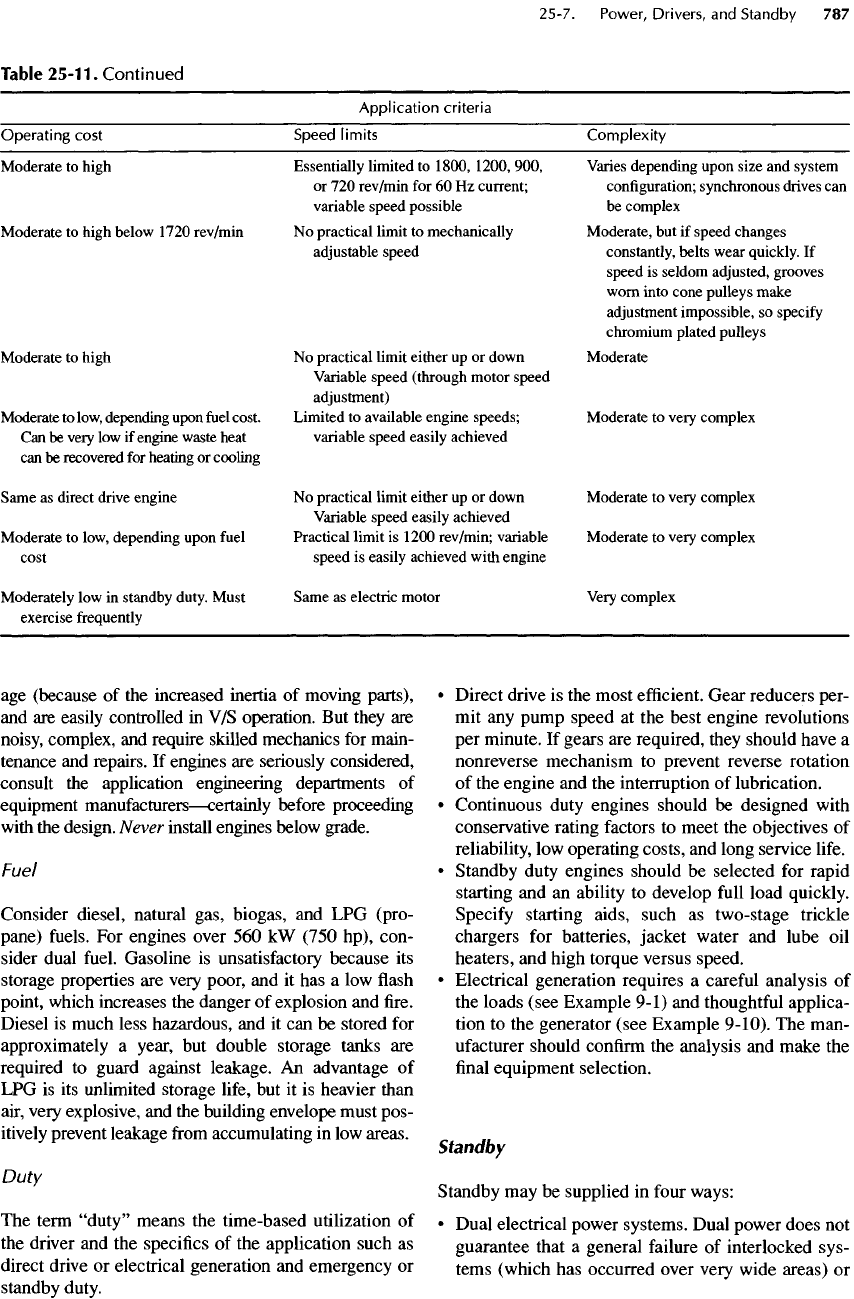
age
(because
of the
increased inertia
of
moving parts),
and
are
easily controlled
in V/S
operation.
But
they
are
noisy,
complex,
and
require skilled mechanics
for
main-
tenance
and
repairs.
If
engines
are
seriously considered,
consult
the
application engineering departments
of
equipment
manufacturers
—
certainly
before
proceeding
with
the
design.
Never
install engines below grade.
Fuel
Consider
diesel, natural gas, biogas,
and LPG
(pro-
pane)
fuels.
For
engines over
560
kW
(750 hp), con-
sider dual
fuel.
Gasoline
is
unsatisfactory because
its
storage properties
are
very poor,
and it has a low flash
point, which increases
the
danger
of
explosion
and fire.
Diesel
is
much less hazardous,
and it can be
stored
for
approximately
a
year,
but
double storage tanks
are
required
to
guard against leakage.
An
advantage
of
LPG is its
unlimited storage
life,
but it is
heavier than
air, very explosive,
and the
building envelope must pos-
itively
prevent leakage
from
accumulating
in low
areas.
Duty
The
term
"duty"
means
the
time-based utilization
of
the
driver
and the
specifics
of the
application such
as
direct drive
or
electrical generation
and
emergency
or
standby
duty.
•
Direct drive
is the
most
efficient.
Gear reducers per-
mit any
pump speed
at the
best engine revolutions
per
minute.
If
gears
are
required, they should have
a
nonreverse mechanism
to
prevent reverse rotation
of
the
engine
and the
interruption
of
lubrication.
•
Continuous duty engines should
be
designed with
conservative rating factors
to
meet
the
objectives
of
reliability,
low
operating costs,
and
long service
life.
•
Standby
duty
engines should
be
selected
for
rapid
starting
and an
ability
to
develop
full
load quickly.
Specify
starting aids, such
as
two-
stage
trickle
chargers
for
batteries, jacket water
and
lube
oil
heaters,
and
high torque versus speed.
•
Electrical generation requires
a
careful
analysis
of
the
loads (see Example
9-1)
and
thoughtful
applica-
tion
to the
generator (see Example 9-10).
The
man-
ufacturer
should
confirm
the
analysis
and
make
the
final
equipment selection.
Standby
Standby
may be
supplied
in
four
ways:
•
Dual electrical power systems. Dual power does
not
guarantee that
a
general
failure
of
interlocked sys-
tems (which
has
occurred over very wide areas)
or
Table
25-1
!.Continued
Operating
cost
Moderate
to
high
Moderate
to
high below 1720 rev/min
Moderate
to
high
Moderate
to
low, depending upon
fuel
cost.
Can be
very
low if
engine waste heat
can
be
recovered
for
heating
or
cooling
Same
as
direct drive engine
Moderate
to
low, depending upon
fuel
cost
Moderately
low in
standby duty. Must
exercise frequently
Application
criteria
Speed
limits
Essentially limited
to
1800,
1200,
900,
or 720
rev/min
for 60 Hz
current;
variable
speed
possible
No
practical
limit
to
mechanically
adjustable speed
No
practical
limit
either
up or
down
Variable speed (through motor speed
adjustment)
Limited
to
available engine
speeds;
variable speed easily achieved
No
practical
limit
either
up or
down
Variable
speed
easily achieved
Practical
limit
is
1200
rev/min; variable
speed
is
easily achieved with engine
Same
as
electric
motor
Complexity
Varies depending upon size
and
system
configuration; synchronous drives
can
be
complex
Moderate,
but if
speed
changes
constantly, belts wear quickly.
If
speed
is
seldom adjusted, grooves
worn
into
cone
pulleys make
adjustment
impossible,
so
specify
chromium plated pulleys
Moderate
Moderate
to
very complex
Moderate
to
very
complex
Moderate
to
very complex
Very
complex
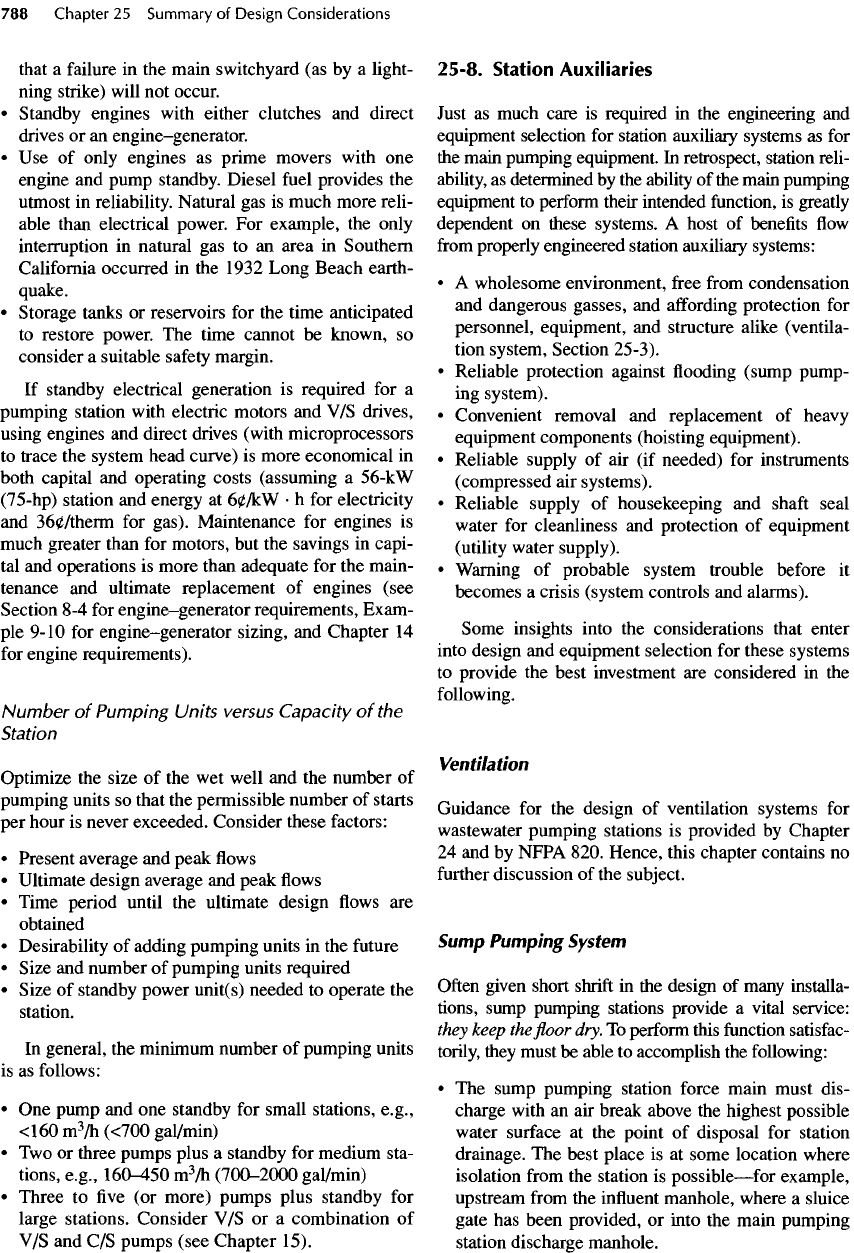
that
a
failure
in the
main switchyard
(as by a
light-
ning
strike) will
not
occur.
•
Standby engines with either clutches
and
direct
drives
or an
engine-generator.
• Use of
only engines
as
prime movers with
one
engine
and
pump standby. Diesel
fuel
provides
the
utmost
in
reliability. Natural
gas is
much more reli-
able than electrical power.
For
example,
the
only
interruption
in
natural
gas to an
area
in
Southern
California
occurred
in the
1932
Long Beach earth-
quake.
•
Storage tanks
or
reservoirs
for the
time anticipated
to
restore power.
The
time cannot
be
known,
so
consider
a
suitable
safety
margin.
If
standby electrical generation
is
required
for a
pumping
station with
electric
motors
and V/S
drives,
using
engines
and
direct drives (with microprocessors
to
trace
the
system head curve)
is
more economical
in
both
capital
and
operating costs (assuming
a
56-kW
(75-hp)
station
and
energy
at
60/kW
• h for
electricity
and
360/therm
for
gas).
Maintenance
for
engines
is
much
greater than
for
motors,
but the
savings
in
capi-
tal and
operations
is
more than adequate
for the
main-
tenance
and
ultimate replacement
of
engines
(see
Section
8-4 for
engine-generator
requirements, Exam-
ple
9-10
for
engine-generator
sizing,
and
Chapter
14
for
engine requirements).
Number
of
Pumping
Units
versus
Capacity
of the
Station
Optimize
the
size
of the wet
well
and the
number
of
pumping
units
so
that
the
permissible number
of
starts
per
hour
is
never exceeded. Consider these factors:
•
Present average
and
peak
flows
•
Ultimate design average
and
peak
flows
•
Time period until
the
ultimate design
flows are
obtained
•
Desirability
of
adding pumping units
in the
future
•
Size
and
number
of
pumping units required
•
Size
of
standby power unit(s) needed
to
operate
the
station.
In
general,
the
minimum number
of
pumping units
is as
follows:
• One
pump
and one
standby
for
small stations,
e.g.,
<160
m
3
/h
(<700
gal/min)
• Two or
three pumps plus
a
standby
for
medium
sta-
tions,
e.g.,
160-450
m
3
/h
(700-2000
gal/min)
•
Three
to five (or
more) pumps plus standby
for
large stations. Consider
V/S or a
combination
of
V/S
and C/S
pumps
(see
Chapter
15).
25-8. Station
Auxiliaries
Just
as
much care
is
required
in the
engineering
and
equipment
selection
for
station auxiliary systems
as for
the
main pumping equipment.
In
retrospect, station reli-
ability,
as
determined
by the
ability
of the
main pumping
equipment
to
perform their intended
function,
is
greatly
dependent
on
these systems.
A
host
of
benefits
flow
from
properly engineered station auxiliary systems:
• A
wholesome environment,
free
from
condensation
and
dangerous gasses,
and
affording
protection
for
personnel, equipment,
and
structure alike (ventila-
tion system, Section 25-3).
•
Reliable protection against
flooding
(sump pump-
ing
system).
•
Convenient removal
and
replacement
of
heavy
equipment components (hoisting equipment).
•
Reliable supply
of air (if
needed)
for
instruments
(compressed
air
systems).
•
Reliable supply
of
housekeeping
and
shaft
seal
water
for
cleanliness
and
protection
of
equipment
(utility
water supply).
•
Warning
of
probable system trouble before
it
becomes
a
crisis (system controls
and
alarms).
Some insights into
the
considerations that enter
into design
and
equipment selection
for
these systems
to
provide
the
best investment
are
considered
in the
following.
Ventilation
Guidance
for the
design
of
ventilation systems
for
wastewater
pumping stations
is
provided
by
Chapter
24 and by
NFPA
820.
Hence, this chapter contains
no
further
discussion
of the
subject.
Sump
Pumping
System
Often
given short
shrift
in the
design
of
many
installa-
tions, sump pumping stations provide
a
vital service:
they
keep
the floor
dry.
To
perform this
function
satisfac-
torily, they must
be
able
to
accomplish
the
following:
• The
sump pumping station force main must
dis-
charge with
an air
break above
the
highest possible
water
surface
at the
point
of
disposal
for
station
drainage.
The
best place
is at
some location where
isolation
from
the
station
is
possible
—
for
example,
upstream
from
the
influent
manhole, where
a
sluice
gate
has
been provided,
or
into
the
main pumping
station discharge manhole.
